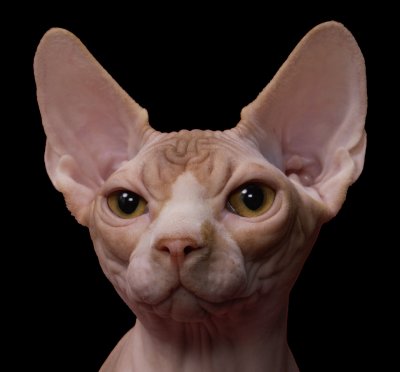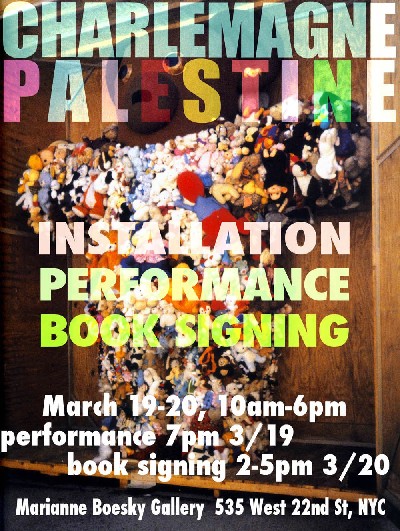 |
[Here is a response to my posting of a picture of a hairless cat several months ago (which now ranks on Google?!). As some of you have noted, it wasn't truly "hairless," and David Jordan below explains why the mix-up happened. Below is one of the cats from his site, well worth visiting!]

If you do a search for "hairless cat" on yahoo you come up #5. I run a site for hairless cats and thought I should point out a couple of things for your edification. They are called Sphynx not Sphinx cats. The cat pictured on your page is indeed a Devon Rex or a very poor example of a Sphynx as it has hair. All Sphynx cats are born with a kind of "suede" hair and keep it their whole life. They are not truly a hairless cat. There is one however that was bred from some cats in Hawaii (i forget the name) Anyhow if you want to get some pics of Sphynx cats you can check out our site http://www.hairlesscatbreeders.com and feel free to grab any you wish. I will be updating a few of the kittens tonight. Just a note to educate.
David Jordan
Have you paid your monthly visit to Y0UNG-HAE CHANG HEAVY INDUSTRIES? Try Dakota, you won't regret it. Turn up the volume if you can (don't watch it without sound).
Well, the subject line says it all... Michael's a great and funny poet, Google him at will and find out!
SEGUE READING SERIES
AT THE BOWERY POETRY CLUB
Winter / Spring 2004
308 BOWERY, JUST NORTH OF HOUSTON
SATURDAYS FROM 4 - 6 PM
$5 admission goes to support the readers
MARCH 13
BRIAN KIM STEFANS and MICHAEL GIZZI
Brian Kim Stefans' latest book is Fashionable Noise: On Digital Poetics. His website is www.arras.net. He's recently taken up playwriting and will premiere a short piece at Chashama in February.
Michael Gizzi moved to Providence last summer. His most recent book is My Terza Rima (The Figures). He will read from his latest ms. Facing Life.
Raymond Hernandez {Bass Guitar and Vocals} has been the bass player for Knight Riders since March of 2000. He has been involved in the world of live music for 30 years. With God's help, at a very young age, he taught himself to play guitar and sing. He has been a member of the choir at St. Andrew's Catholic Church in Channelview, TX for 25 years and is very much involved in several other church organizations. Before joining Knight Riders, he operated the band Southern Justice for nearly 4 years. In November of 1999, Raymond had a challenge slap him in the face when he severed the end of his index finger with a circular saw. In less than a week, he managed to create new ways to play his chords and fought through the pain so that he would not miss a gig. Today, his finger is of no challenge to his performance. He entertains any and every crowd no matter how small or large and still makes it to church every Sunday.
(He won't be appearing at this reading.)
[One you don't want to miss...]

March 19-20, 2004
Friday, March 19, 7pm PERFORMANCE
Saturday, March 20, 2-5pm BOOK SIGNING
Marianne Boesky Gallery is pleased to present a weekend celebration of the seminal visual/performance/sound artist Charlemagne Palestine and the premiere launch of “Sacred Bordello” (2004, Black Dog Press), a comprehensive monograph including essays, scores, and original photos of both his performances and installations. This represents the first major publication on Charlemagne Palestine’s art. In attempting to convey the breadth of Palestine’s artistic activity, the gallery will present an installation of paintings and sculptures, a sound environment, and a rare body performance by the artist.
Born in Brooklyn in 1947, Palestine’s first musical experiences were as a cantorial singer in the synagogues of New York. By the late 1960s, he was deeply involved in the amazingly fertile New York and West Coast experimental music/art community. His first major works were legendary piano performances of epic durations, microtonal trembles and dense overtones which situated him alongside La Monte Young, Terry Riley, Steve Reich and others as a seminal figure of early minimalism.
In the early 1970s, Palestine increasingly extended his performances beyond the scope of music. His groundbreaking appearances, which combined violent piano playing, performance, video and installation, were considered to be among the most radical musical and performance experiences. Palestine produced a seminal body of performance-based, psychodramatic videotapes in which he ritualistically used physicality, motion and sound to achieve an outward articulation of internal states. Intense and often violently charged, these exercises are characterized by a visceral enactment of physical and psychological catharses.
Palestine’s artistic concerns have also manifested themselves in countless gallery installations. The publication of “Sacred Bordello” places particular emphasis on this aspect of Palestine’s work, which is often much less known by American audiences, especially as Palestine has lived for several years in Belgium and has exhibited primarily in Europe. His signature assemblies of often-augmented stuffed animals, scarves, and objects (collectively called “Charleworld” by the artist) convey both an unruly flamboyance and a penetrating poignancy—a duality which extends through all of Palestine’s varied activities.
The gallery installation will be open 10am-6pm on March 19th and 20th. Please call 212-680-9889 for further information.
The Australian digital poet geniwate and I have two collaborations up as part of the page_space project exhibition that is presently on view at Machine Project, 1200 D North Alvarado, Los Angeles.
I did the text and photographs for "Kyoto" and geni did the programming, sound, and filters on the images. For the second, geni provided the text and the concept (including the Quicktime video she found online), I did the programming and work with the stills.
Neither of us are entirely satisfied that these are the final versions of the pieces; we plan to revise them and submit them to How2 or some other online poetry center.
But for now take a peeksy, let me know what you think. Other artists in the exhibition include: Simon Biggs, Loss Glazier, Deena Larsen, Jody Zellen, Pedro Valdeolmillos, Lluís Calvo, Jim Andrews and Jason Nelson.
The propaganda from Anton Soderman:
page_space project
The space of the page has long been taken for granted as blank, while text is valorized as the agent of signification. But what is the space of the page? What are it's architectures which quietly construct the possiblilities of a text? As spaces for writing multiply, perhaps infatuation with literary style will be replaced by the stylistics of the page, and a desire to create mechanisms that that offer new spaces for writing.
Traditionally, collaborations between writers and programmers move from pages of text to the forms of the screen: a writer first composes a text that the programmer then designs, arranges and presents. The page_space project is an experiment conducted under the direction of Senior Research Coordinator Anton Soderman which reverses the usual collaboration between writing and design. First, programmers and designers created digital page architectures. These spaces were then exchanged and used as fields for textual exploration.
The page_space programmer/writers are: Simon Biggs, Lluis Calvo, geniwate, Loss Pequeño Glazier, Deena Larsen, Jason Nelson, Brian Kim Stefans, Pedro Valdeolmillos and Jody Zellen.
The page_space project goes online on February 28, 2004, and initiates the Machine Poetics Research Unit of Superbunker.